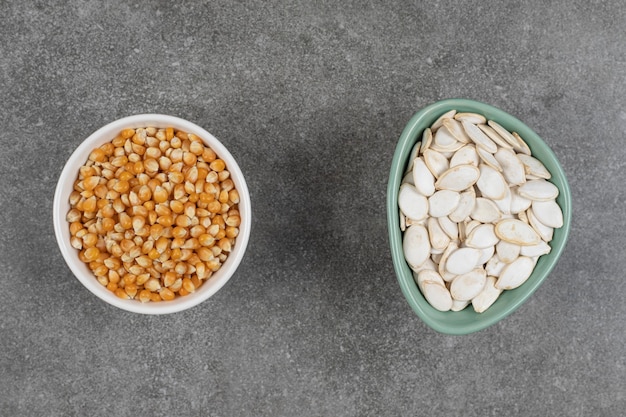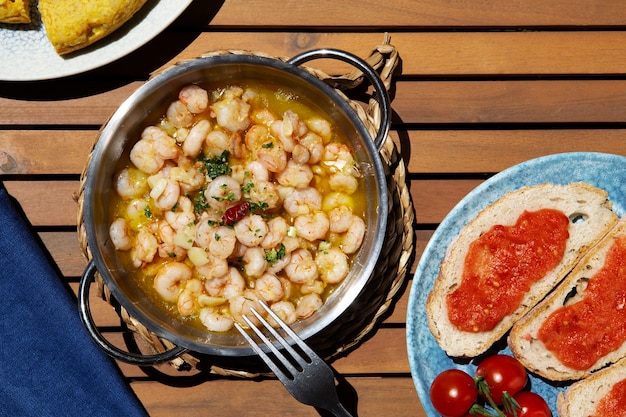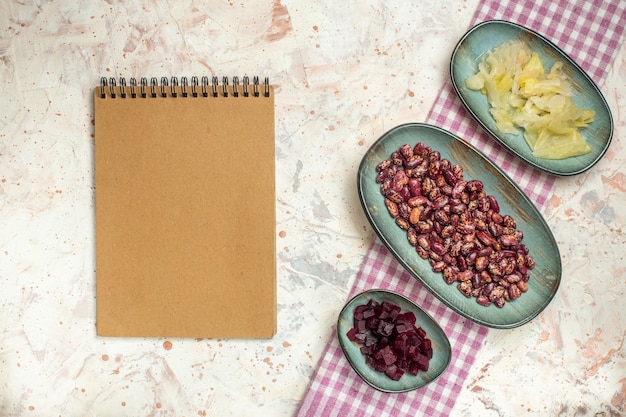(Part 1) The Bean Basics: Choosing the Right Ones

Before we even get to the cooking, we need to pick the right beans. Not all white beans are created equal, and each variety has its own unique personality and best uses.
1.1. The Great White Bean Lineup: A Flavorful Cast of Characters
Here are some of the most common white beans you'll find in the supermarket, along with their signature characteristics:
- cannellini beans: These are my go-to beans for creamy soups, dips, and salads. They have a mild flavour and a wonderfully smooth texture when cooked. They hold their shape well, making them perfect for chunky dishes. Think of them as the "chameleon" of the white bean world, adaptable to various recipes.
- Great Northern Beans: The name says it all! These are the quintessential white beans for baking beans, salads, and hearty stews. They're slightly smaller than cannellinis and have a slightly firmer texture. They're like the reliable "workhorse" of the bunch, adding substance and heartiness to any dish.
- Navy Beans: These little guys are the classic choice for Boston baked beans. They cook quickly and have a delicate flavour, perfect for absorbing other flavours. Think of them as the "sponges" of the bean world, taking on the flavors of their surroundings.
- butter beans: These large, buttery beans are the stars of southern cooking. They have a rich flavour and a creamy texture, making them ideal for stews, casseroles, and even dips. They're the "drama queens" of the bean world, adding a touch of luxurious creaminess to any dish.
- White kidney beans: These beans are often used in Mexican cuisine. They have a mild flavour and a firm texture, making them suitable for salads, salsas, and soups. They're the "versatile performers" of the bean world, adding a touch of texture and substance to a wide range of dishes.
1.2. Canned vs. Dried: A Quick Comparison
When it comes to white beans, you have two main options: canned or dried. I love both, but each has its own advantages:
- Canned: Convenience is the name of the game here. They're already cooked, so you can just open a can and add them to your dish. They have a slightly softer texture than dried beans, but they're still delicious. Just be sure to rinse them thoroughly to remove the excess salt and liquid. They're like the "instant gratification" of the bean world, perfect for those nights when you need a quick and easy meal.
- Dried: Dried beans offer the opportunity to control the flavour and texture. You can soak them in water overnight, which helps soften them and reduces cooking time. They also tend to have a more intense flavour than canned beans. They're like the "artisan" of the bean world, requiring a bit more effort but yielding a deeper, more complex flavor.
1.3. My Personal Preference: Dried All the Way
I'm a firm believer in starting with dried beans. The flavour is just richer and more complex. It's like the difference between fresh-baked bread and store-bought. Plus, it's super satisfying to watch those tiny beans transform into a hearty meal.
(Part 2) The Art of Soaking: A Step Toward Perfect Beans

Okay, let's say you're going with dried beans. Soaking is the first crucial step. It makes the beans cook faster and more evenly, and it helps reduce the risk of digestive issues.
2.1. The Soaking Process: Unleashing the Bean's Potential
Here's how to soak your beans like a pro:
- Pick 'em Clean: Give your beans a thorough rinse to remove any debris or small stones. Think of it like giving your beans a mini spa treatment before their transformation.
- The Soaking Ratio: Use a ratio of 3 parts water to 1 part beans. For example, if you're using 1 cup of beans, use 3 cups of water. This ensures the beans have enough water to soak up and soften.
- Soak Time: Soak your beans overnight, for at least 8 hours, or up to 24 hours. Let them rest and relax in the water, giving them time to absorb moisture and soften.
2.2. Soaking Secrets: Tips for Perfect Beans
Here are a few tips to elevate your soaking game:
- The Fridge Trick: Soaking in the refrigerator overnight can help control the temperature and prevent the beans from fermenting. This keeps your beans fresh and prevents any unwanted funky flavours from developing.
- Add a Pinch of Salt: A small amount of salt in the soaking water helps the beans retain their shape and prevents them from becoming too mushy. It's like giving them a little bit of support and structure.
- Don't Discard the Soaking Liquid: This is called aquafaba, and it's a magical ingredient that can be used as an egg replacement or a thickening agent. It's like finding a hidden treasure in your bean soaking process! We'll talk more about aquafaba later on.
(Part 3) Mastering the Art of Cooking: From Stovetop to instant pot

Now that your beans are soaked, it's time to cook them to perfection. There are a few different methods, each with its own pros and cons.
3.1. Stovetop Cooking: The Classic Method
Stovetop cooking is the tried-and-true way to cook beans. It's simple, affordable, and gives you complete control over the cooking process. It's like the traditional way of doing things, allowing you to simmer and savor the process.
- The Magic Ratio: Use a ratio of 2 parts water to 1 part beans. For example, if you're using 1 cup of beans, use 2 cups of water. This ensures the beans have enough liquid to cook evenly and become tender.
- Bring it to a Boil: Bring the beans and water to a rolling boil over high heat. Then, reduce the heat to a low simmer. This initial boil helps the beans cook more quickly and evenly.
- Cook it Slow: Simmer the beans for 1 to 2 hours, or until they are tender but not mushy. Let them gently simmer and transform into deliciousness.
- Taste Test: Test the beans for tenderness by mashing one with a spoon. If it's easily mashed, they're ready. It's a simple test that ensures the beans are perfectly cooked.
3.2. pressure cooker (Instant Pot) Magic: Fast and Fuss-Free
If you're short on time, the Instant Pot is your best friend. It's amazing for cooking beans quickly and effortlessly. It's like having a magical bean-cooking machine that does all the work for you.
- Instant Pot Ratio: Use a ratio of 3 parts water to 1 part beans. For example, if you're using 1 cup of beans, use 3 cups of water. The Instant Pot requires a bit more water to build up pressure and cook the beans evenly.
- Pressure Cooker Power: Cook beans on high pressure for 30 to 40 minutes, depending on the type of beans. Let the Instant Pot do its magic and transform your beans in a fraction of the time.
- Natural Release: After the cooking time is up, let the pressure release naturally for 10 minutes before releasing the remaining pressure manually. This allows the beans to cook more evenly and prevents them from becoming too mushy.
(Part 4) The Secret to Tender and Flavorful Beans: Beyond Just Cooking
There are a few tricks up my sleeve to make sure your beans are not only cooked through but also brimming with flavour. It's not just about the cooking process; it's about the little touches that elevate the flavor.
4.1. The Salt Situation: A Matter of Timing
When it comes to salt, there's a bit of debate. Some people like to add salt at the beginning of the cooking process, while others prefer to wait until the end. I'm in the "wait until the end" camp. Adding salt too early can make the beans tougher, and it can also affect their flavour. It's like letting the beans develop their own natural flavor first, before adding salt to enhance it.
4.2. Flavor Boosters: Herbs and Spices
Don't be afraid to experiment with herbs and spices. They'll add depth and complexity to your beans. It's like adding a splash of personality and flair to your bean creations.
- Classics: Bay leaves, thyme, rosemary, oregano, and garlic are great for adding a classic touch. They're like the tried-and-true friends of the bean world, always adding a touch of warmth and familiarity.
- Global Flavours: For a Mexican twist, try cumin, coriander, and chili powder. For a Mediterranean vibe, add oregano, lemon zest, and olive oil. It's like opening a window to different culinary cultures, bringing a new dimension of flavor to your beans.
4.3. The Art of Bean Broth: Saving the Cooking Liquid
Don't throw away that delicious bean broth! It's packed with flavor and can be used in soups, stews, and sauces. It's like liquid gold, full of flavor and potential for culinary creations.
4.4. The "Bean Brain": Don't Overcook
It's easy to get carried away and overcook your beans. Remember, the goal is tender but not mushy. If they start to break down, turn off the heat and let them sit for a few minutes. It's like knowing when to stop and appreciate the beauty of a perfectly cooked bean.
(Part 5) Storage and Beyond: Keeping Your Beans Fresh and Delicious
You've cooked your perfect beans, now what? Proper storage is key to preserving their flavour and texture. It's like making sure your culinary masterpiece stays fresh and ready for its starring role in your next meal.
5.1. Refrigeration Rules: Keeping Beans Fresh
Store cooked beans in an airtight container in the refrigerator for up to 5 days. This keeps them safe and delicious for a few days, ready to be used in a variety of dishes.
5.2. Freezing for Future Use: Storing Beans for Later
You can also freeze cooked beans for up to 3 months. Just make sure to use freezer-safe containers and leave some space for expansion. This allows you to enjoy the taste of freshly cooked beans whenever you want, even weeks or months later.
5.3. Beyond the Basics: Bean Inspiration: Unleash Your Culinary Creativity
Now that you've mastered the art of cooking white beans, it's time to get creative! Here are a few ideas to get you started:
- Creamy bean soups: Cannellini beans are perfect for creamy soups, like white bean and kale soup or Tuscan white bean soup. They add a silky smooth texture and subtle flavor to any soup.
- Hearty Stews and Chilis: Great Northern beans are excellent for adding substance to stews and chilis. They provide a hearty texture and absorb the flavors of the other ingredients.
- Salads and Sides: Navy beans are delicious in salads, like three-bean salad or Greek white bean salad. They add a satisfying crunch and a hint of earthy flavor to any salad.
- Bean Burgers: White beans are the star ingredient in vegetarian bean burgers. They provide a hearty texture and a delicious flavor, making them a perfect alternative to traditional burgers.
- Dips and Spreads: Butter beans make a creamy and delicious base for dips and spreads. Their buttery texture and richness make them perfect for spreading on crackers or dipping vegetables.
(Part 6) Beyond the Kitchen: bean nutrition Power: A nutritional powerhouse
White beans aren't just delicious; they're also packed with nutritional power. They're like a superfood in disguise, full of goodness for your body and mind.
6.1. A Protein Powerhouse: Fueling Your Body
White beans are a great source of protein, making them a fantastic option for vegetarians and vegans. They provide a complete protein source, helping to build and repair muscle tissue.
6.2. Fiber Frenzy: Supporting Digestive Health
They're also high in fiber, which is essential for digestive health and can help keep you feeling full and satisfied. Fiber helps regulate digestion and promotes a healthy gut.
6.3. Mineral Marvels: A Treasure Trove of Minerals
White beans are a good source of various minerals, including iron, potassium, and magnesium. These minerals are essential for a variety of bodily functions, including blood health, muscle function, and nerve function.
(Part 7) The Unexpected Bean Adventure: Beyond the Basic: Exploring New Horizons with Beans
Now that you're a seasoned bean cook, let's explore some unexpected ways to use white beans. Let your creativity run wild and discover new possibilities with this versatile ingredient.
7.1. Bean Burgers: The Vegetarian Hero: A Delicious and Nutritious Alternative
White beans are the perfect base for vegetarian burgers. They provide a hearty texture and a delicious flavour. They're a perfect way to enjoy a plant-based burger that's both satisfying and flavorful.
7.2. Bean Pastes and Spreads: A Global Delight: A World of Flavor in a Spread
White beans can be blended into creamy pastes and spreads. Try making a white bean hummus or a creamy bean dip. It's a simple way to add a touch of creamy goodness to any meal or snack.
7.3. Aquafaba: The Egg Replacement: The Magic of Bean Water
Remember that bean soaking liquid? It's called aquafaba, and it's a fantastic egg replacement in baking. Try using it in meringues, cakes, or even vegan mayonnaise. It's like discovering a hidden gem in your kitchen, giving you a new ingredient to experiment with.
(Part 8) FAQs: Your Bean-Cooking Questions Answered: Addressing the Common Concerns
Let's address those burning bean questions you might have. I'm here to answer your questions and provide clear and concise answers to ensure your bean-cooking journey is smooth and enjoyable.
8.1. What If My Beans Are Gassy?
Beans have a reputation for causing gas. It's due to the sugars in the beans that our bodies can't easily digest. Here are a few tips to reduce gas:
- Soak them longer: soaking beans for longer helps break down some of those sugars. It's like giving your body a head start in digesting the beans.
- Add digestive enzymes: These supplements can help break down the sugars in beans. They're like little helpers that make the digestion process easier.
- Eat them in moderation: Start with small portions and gradually increase as your body gets used to them. It's like easing your body into the world of beans.
8.2. Can I Cook Beans Without Soaking?
You can, but it will take longer. If you choose to skip the soaking step, add 1 hour to the cooking time for dried beans. It's like taking a shortcut, but it will take a little longer to reach your destination.
8.3. How Do I Know When My Beans Are Done?
Test them by mashing one with a spoon. If it's easily mashed, they're done. You should also be able to easily pierce them with a fork. It's a simple test to ensure your beans are cooked to perfection.
8.4. How Long Can I Store Cooked Beans in the Fridge?
Cooked beans can be stored in the fridge for up to 5 days in an airtight container. This allows you to enjoy your freshly cooked beans for a few days, ready for any culinary creation.
8.5. Can I Freeze Cooked Beans?
Yes, you can freeze cooked beans for up to 3 months. Make sure to use freezer-safe containers and leave some space for expansion. This allows you to stock up on cooked beans and enjoy them whenever you want.
(Part 9) The Bean Journey: A Final Word: Embracing the Bean Adventure
There you have it, your ultimate guide to cooking perfect white beans. From choosing the right beans to understanding cooking techniques, you now have the knowledge and confidence to create delicious and nutritious bean dishes.
Remember, cooking is a journey, not a destination. Embrace the process, experiment with flavours, and enjoy the endless possibilities of white beans. It's like embarking on a culinary adventure, discovering new flavors and creating your own bean masterpieces. Happy cooking!
Everyone is watching

How to Cook Frozen Lobster Tails Perfectly: A Step-by-Step Guide
RecipesLobster. Just the word conjures up images of lavish meals, special occasions, and a taste of luxury. But let's...

Pigs in a Blanket Cooking Time: How Long to Bake for Perfect Results
RecipesAh, pigs in a blanket. Just the name conjures up images of those delightful little parcels of crispy pastry en...

Pork Fillet Cooking Time: How Long to Cook It Perfectly
RecipesPork fillet, or tenderloin as it's sometimes called, is a real favourite in our house. It's so versatile, and...

The Ultimate Guide to Tender, Juicy Pulled Pork
RecipesRight, let's talk pulled pork. It's one of those dishes that just screams "comfort food," doesn't it? I mean...

The Ultimate Guide to Cooking Sweet Potatoes: From Roasting to Mashing
RecipesSweet potatoes. Just the name conjures up images of warm, comforting dishes, bursts of vibrant color, and a to...
